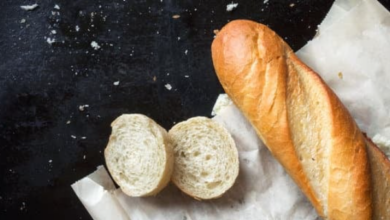Baguette Dough: What It Should Look Like

What To Know
- Achieving the perfect baguette dough is a delicate art, and the dough’s appearance plays a crucial role in determining its final quality.
- Adjust the kneading technique to develop the gluten and create a strong dough structure.
- The reward is a golden-brown baguette with a crisp crust, a chewy interior, and an unforgettable flavor that will delight bread enthusiasts everywhere.
Baguettes, the quintessential French bread, are renowned for their crispy crust and airy, chewy interior. Achieving the perfect baguette dough is a delicate art, and the dough’s appearance plays a crucial role in determining its final quality. In this comprehensive guide, we will delve into the characteristics of ideal baguette dough, providing bakers with the knowledge to assess and perfect their dough’s appearance for exceptional results.
Characteristics of Ideal Baguette Dough:
1. Consistency:
- Well-developed dough should possess a smooth, silky, and elastic texture.
- The dough should not be sticky or overly firm, allowing for easy shaping and handling.
2. Color:
- The dough should exhibit a creamy white or slightly yellowish hue.
- Consistent coloration indicates proper fermentation and gluten development.
3. Surface Texture:
- A healthy dough will have a smooth and slightly shiny surface.
- Rough or cracked surfaces may indicate over-fermentation or improper handling.
4. Stretchability:
- The dough should exhibit good extensibility, allowing it to be stretched without tearing.
- Adequate gluten development contributes to the dough’s stretchability.
5. Elasticity:
- When gently stretched, the dough should snap back into shape quickly.
- Elasticity is essential for maintaining the baguette’s structure during proofing and baking.
6. Fermentation Activity:
- The dough should show signs of fermentation, such as small bubbles on the surface.
- Proper fermentation contributes to the dough’s flavor, texture, and aroma.
7. Proofing:
- During proofing, the dough should rise evenly and maintain its shape.
- Over-proofing can lead to a collapsed or misshapen baguette.
Common Dough Problems and Solutions:
1. Sticky Dough:
- Solution: Adjust the hydration level by adding more flour or reducing the amount of water.
- Knead the dough longer to develop the gluten and improve its structure.
2. Dry Dough:
- Solution: Gradually add small amounts of water to the dough until it reaches the desired consistency.
- Knead the dough thoroughly to ensure even hydration.
3. Cracked Dough:
- Solution: Allow the dough to rest for a longer period before shaping.
- Handle the dough gently to avoid tearing or stretching it excessively.
4. Flat or Dense Dough:
- Solution: Ensure proper fermentation by allowing the dough to rise adequately.
- Adjust the kneading technique to develop the gluten and create a strong dough structure.
5. Over-Proofed Dough:
- Solution: Reduce the proofing time or adjust the fermentation temperature.
- Shape the dough immediately after proofing to prevent collapse.
Tips for Achieving Perfect Baguette Dough:
1. Use high-quality ingredients:
- Choose high-protein flour to ensure adequate gluten development.
- Use filtered or purified water for consistent results.
2. Follow the recipe precisely:
- Accurately measure ingredients and follow the instructions carefully.
- Adjust the hydration level based on the flour’s absorption capacity.
3. Knead the dough properly:
- Knead the dough until it becomes smooth, elastic, and silky.
- Avoid over-kneading, as this can toughen the dough.
4. Allow adequate fermentation:
- Ferment the dough at a warm temperature until it doubles in size.
- Monitor the dough’s fermentation to prevent over-proofing.
5. Shape the dough carefully:
- Gently shape the dough into baguettes without degassing it excessively.
- Ensure uniform shaping to achieve consistent baking results.
6. Proof the dough properly:
- Proof the baguettes in a warm, humid environment until they increase in size by 50-75%.
- Avoid over-proofing, as this can lead to a collapsed or misshapen baguette.
7. Bake the baguettes at a high temperature:
- Preheat the oven to a high temperature to create a crispy crust.
- Steam the oven during baking to promote oven spring and a shiny crust.
Wrapping Up:
Mastering the art of creating perfect baguette dough requires practice and attention to detail. By understanding the ideal characteristics of baguette dough and addressing common problems, bakers can consistently achieve exceptional results. The reward is a golden-brown baguette with a crisp crust, a chewy interior, and an unforgettable flavor that will delight bread enthusiasts everywhere.
Frequently Asked Questions:
1. Q: Why is my baguette dough sticky?
- A: The dough may be too hydrated. Adjust the hydration level by adding more flour or reducing the amount of water.
2. Q: Why is my baguette dough dry and crumbly?
- A: The dough may be under-hydrated. Gradually add small amounts of water to the dough until it reaches the desired consistency.
3. Q: Why does my baguette dough tear easily?
- A: The dough may be under-developed. Knead the dough longer to develop the gluten and improve its structure.
4. Q: Why does my baguette dough not rise properly?
- A: The dough may be under-proofed. Allow the dough to rise adequately at a warm temperature until it doubles in size.
5. Q: Why does my baguette dough collapse after baking?
- A: The dough may be over-proofed. Reduce the proofing time or adjust the fermentation temperature.





